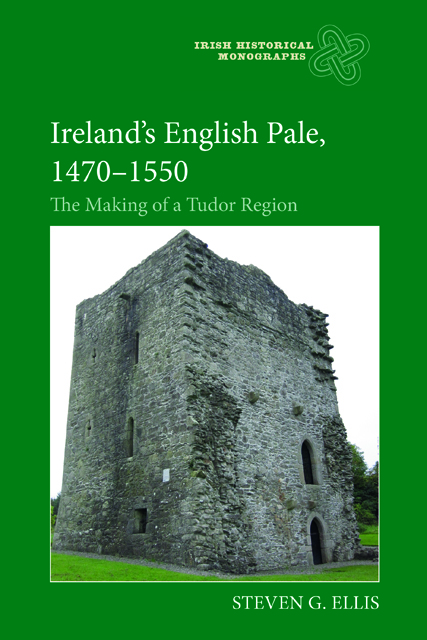Book contents
- Frontmatter
- Contents
- List of Maps
- Preface
- List of Abbreviations
- Introduction: in search of Ireland's English Pale
- 1 The horizons of English rule: retreat and recovery
- 2 The fortifications and identity of a military frontier
- 3 County Dublin and the military frontier
- 4 Strengthening the march in County Kildare
- 5 The English Pale's westward expansion: County Meath
- 6 The English Pale's northern frontier: County Louth
- 7 Restoring the English Pale, 1534-41
- 8 The waning of the English Pale
- Conclusion: an English region in Tudor Ireland
- Bibliography
- Index
- Irish Historical Monographs previous volumes
4 - Strengthening the march in County Kildare
Published online by Cambridge University Press: 09 January 2024
- Frontmatter
- Contents
- List of Maps
- Preface
- List of Abbreviations
- Introduction: in search of Ireland's English Pale
- 1 The horizons of English rule: retreat and recovery
- 2 The fortifications and identity of a military frontier
- 3 County Dublin and the military frontier
- 4 Strengthening the march in County Kildare
- 5 The English Pale's westward expansion: County Meath
- 6 The English Pale's northern frontier: County Louth
- 7 Restoring the English Pale, 1534-41
- 8 The waning of the English Pale
- Conclusion: an English region in Tudor Ireland
- Bibliography
- Index
- Irish Historical Monographs previous volumes
Summary
In ‘Kildare, named one of the four obeisant shires in the English Pale’, not ‘one word of English [is] spoken but all Irish’, also ‘Irish habit and tonsures’ mostly, ‘and Irish garments’. So claimed Robert Cowley, with typical hyberbole, in an early Tudor reform treatise composed about 1526 and lamenting ‘the decay of this land, the increase of Irishmen and enfeebling of the king’s subjects’. A similar complaint, ten years later, by John Alen, master of the rolls, may have also recalled his own problems in procuring tenants for his recently acquired estates on Celbridge manor and St Wolstan’s priory. He observed that
ther is suche scar[ce]nes of thEngly[s]e blodde in this parties, that of force we [be] driven not only to take Iryshe men, our natural enymyes, to our tenauntes and erthetyllers, but also some to our housholde servauntes, some horsemen and kerne.
Cowley’s claim about the absence of English speech in County Kildare was certainly a sweeping exaggeration, but a recent study of ‘cultural exchange and identity’ in ‘the four obedient shires’ confirms earlier suggestions that Kildare had the highest percentage of Irish tenants. This is not, however, a convincing argument for the shire’s increasing ‘gaelicization’, despite the novel claim that ‘only a small corner of north-eastern Kildare ... lay within the Pale’. The preponderance of Irish tenants and customs in Kildare over the other three shires reflected different conditions there, notably the shire’s underlying labour shortage in a period of rising demand, and ultimately its more urgent needs of defence. As is argued below, the expanding frontiers of early Tudor Kildare, and with it the English Pale’s enlarged extent, accommodated an increasing population, an extension of tillage and the restoration of English manorialism on recovered land. Cereal cultivation was more labour-intensive than pastoralism: it both required and sustained a higher population, which in turn facilitated arrangements for the shire’s defence. In terms of the main markers of culture and identity, early Tudor Kildare was in fact becoming more English, despite Cowley’s complaints.
The Kildare maghery was very small, hardly extending beyond the north-eastern baronies of Salt and Naas: most of the shire lay in the marches. The borders of other Pale shires were mostly county boundaries with neighbouring shires, but with small sections of border adjoining the Irishry organized as defended marches.
- Type
- Chapter
- Information
- Ireland's English Pale, 1470-1550The Making of a Tudor Region, pp. 77 - 99Publisher: Boydell & BrewerPrint publication year: 2021



